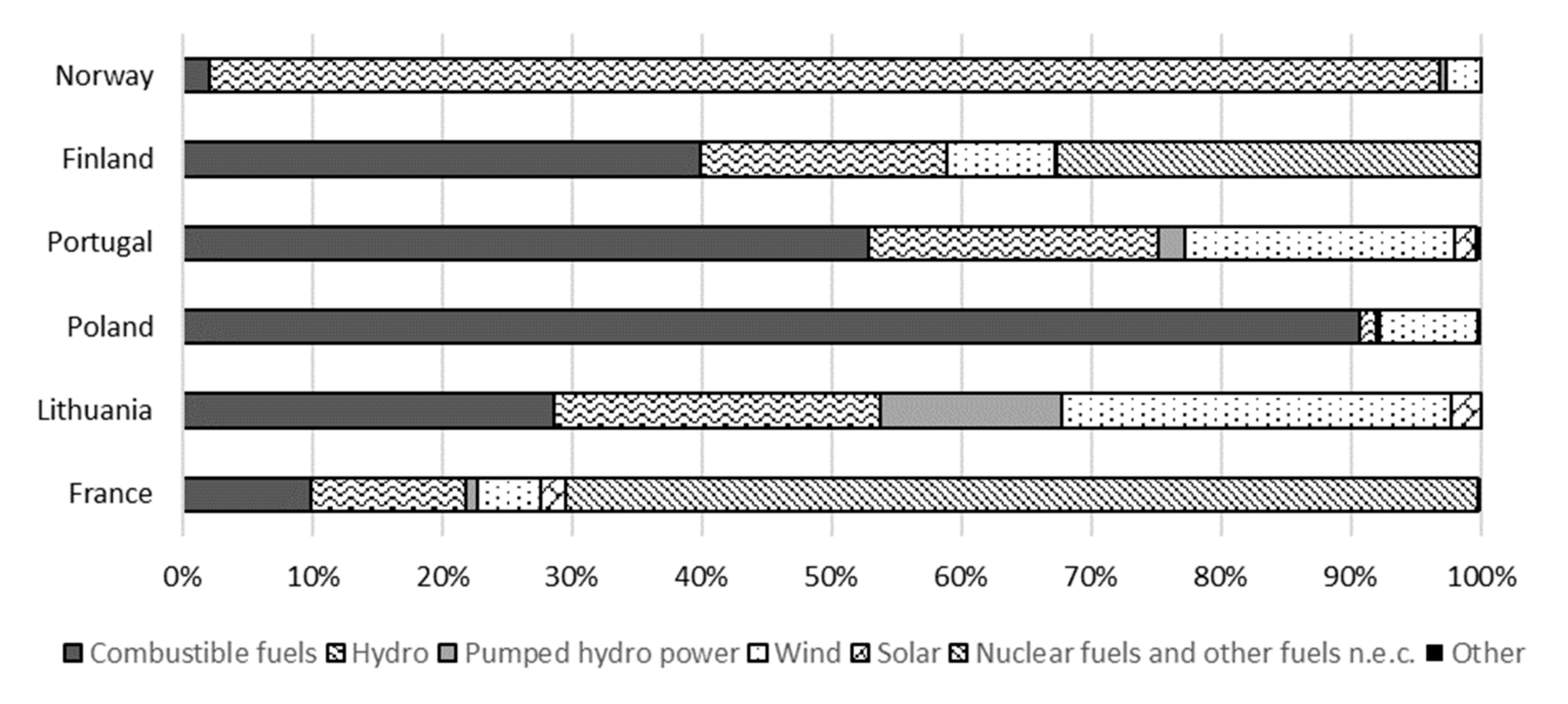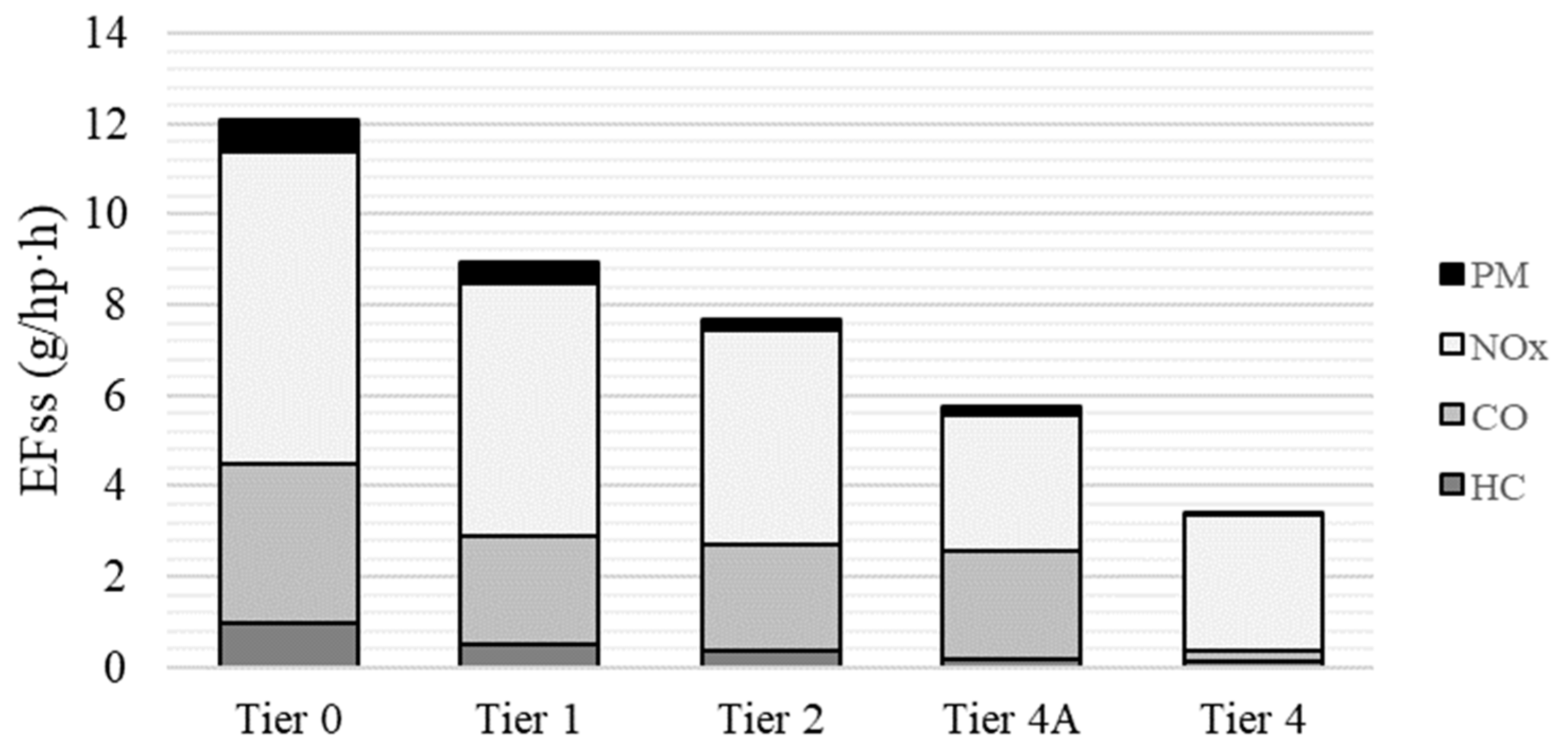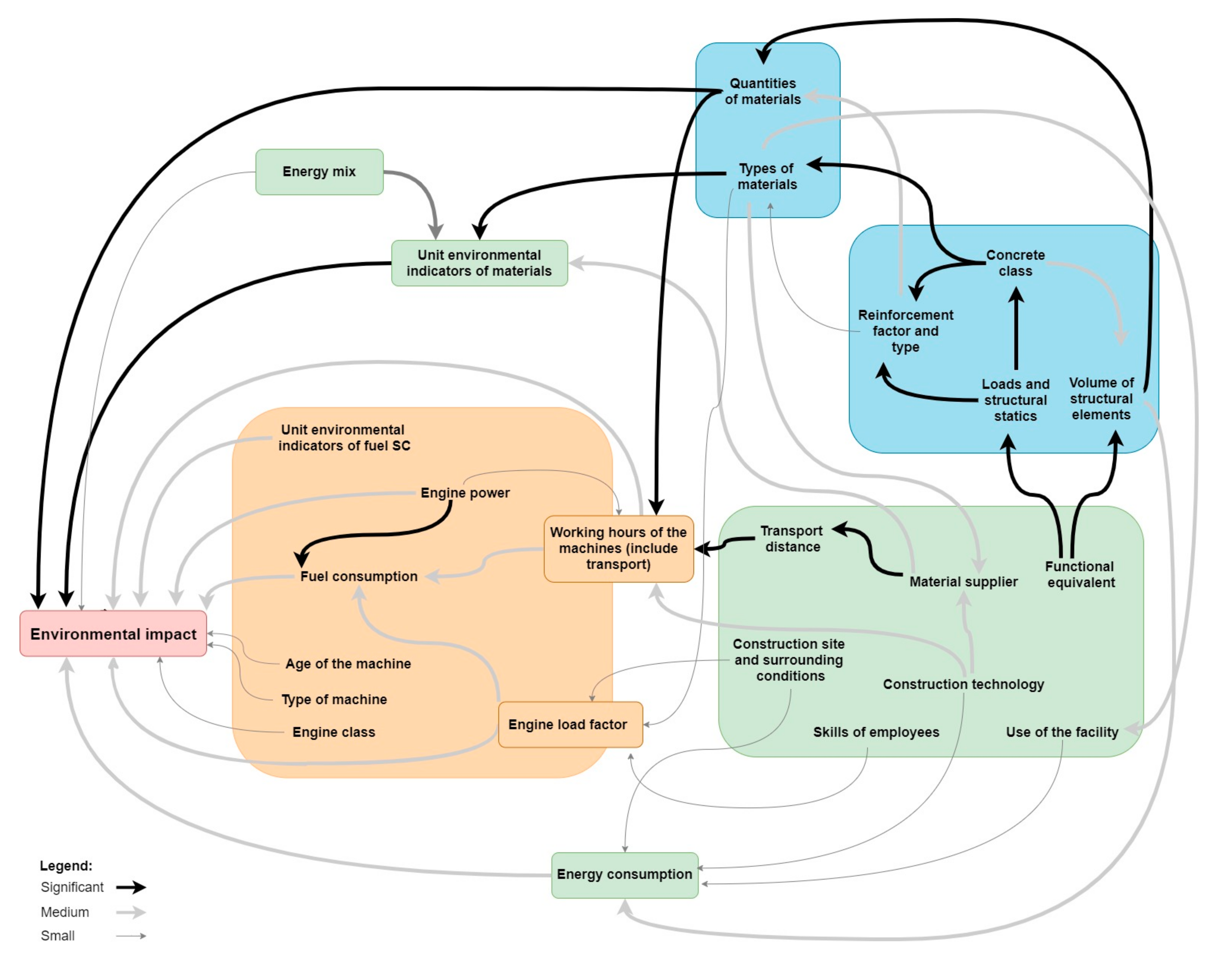Analysis of Factors Affecting the Environmental Impact of Concrete Structures
Abstract
1. Introduction
2. Materials and Methods
2.1. Identification of the Parameters
2.2. Cause-Effect Analysis
- Step I—generate the group direct-influence matrixZ. To assess the relationships between n factors F = {F1, F2, …, Fn} in a system, a direct influence graph was created, where the occurrence of the influence, its direction, and the force of the influence was defined. The following scale of impact was used in the analysis: “no influence” (0), “small influence” (1), “medium influence (2)”, and “significant influence” (3). Based on the graph, a direct influence matrix is obtained:
- Step II—establish the normalized direct-influence matrix X, based on formula:
- Step III—construct the total-influence matrixT. Using the normalized direct-influence matrix X, the total-influence matrix T is computed by summing the direct influence and all of the indirect influence:when , and I is denoted as an identity matrix.
- Step IV—produce the influential relation map (IRM). At this step, the vectors R and C are computed, as the sum of the rows and the sum of the columns from the total-influence matrix T:
3. Identification of the Parameters
3.1. Concrete Mixtures
3.2. Type of Cement
3.3. Raw Material Supply
3.4. Energy-Mix
3.5. Technological Process
3.6. Transport-Related Processes
3.7. Construction-Installation-Demolition Process
3.8. Use Stage
3.9. Waste Management
4. Cause-Effect Analysis Result
5. Summary and Discussion
Funding
Institutional Review Board Statement
Informed Consent Statement
Data Availability Statement
Conflicts of Interest
Appendix A



References
- ERMCO. Ready-Mixed Concrete Industry Statistics-Year 2016; European Ready Mixed Concrete Organization: Brussels, Belgium, 2017. [Google Scholar]
- Teh, S.H.; Wiedmann, T.; Castel, A.; de Burgh, J. Hybrid life cycle assessment of greenhouse gas emissions from cement, concrete and geopolymer concrete in Australia. J. Clean. Prod. 2017, 152, 312–320. [Google Scholar] [CrossRef]
- Kim, T.H.; Chae, C.U. Environmental impact analysis of acidification and eutrophication due to emissions from the production of concrete. Sustainability 2016, 8, 578. [Google Scholar] [CrossRef]
- Shoubi, M.V.; Barough, A.S.; Amirsoleimani, O. Assessment of the Roles of Various Cement Replacements in Achieving the Sustainable and High Performance Concrete. Int. J. Adv. Eng. Technol. 2013, 6, 68–77. [Google Scholar]
- Wałach, D.; Dybeł, P.; Sagan, J.; Gicala, M. Environmental performance of ordinary and new generation concrete structures—a comparative analysis. Environ. Sci. Pollut. Res. 2019, 26, 3980–3990. [Google Scholar] [CrossRef] [PubMed]
- Faleschini, F.; Zanini, M.; Pellegrino, C. Environmental impacts of recycled aggregate concrete. In Proceedings of the Italian Concrete Days—Giornate Aicap 2016 Congresso CTE, Roma, Italy, 27–28 October 2016. [Google Scholar]
- Sobotka, A.; Sagan, J.; Baranowska, M.; Mazur, E. Management of reverse logistics supply chains in construction projects. Procedia Eng. 2017, 208, 151–159. [Google Scholar] [CrossRef]
- Jaskowska-Lemanska, J. Impurities of recycled concrete aggregate-types, origin and influence on the concrete strength parameters. IOP Conf. Ser. Mater. Sci. Eng. 2019, 603. [Google Scholar] [CrossRef]
- Zhu, H.; Wen, C.; Wang, Z.; Li, L. Study on the Permeability of Recycled Aggregate Pervious Concrete with Fibers. Materials 2020, 13, 321. [Google Scholar] [CrossRef]
- Skrzypczak, I.; Kokoszka, W.; Buda-Ożóg, L.; Kogut, J.; Słowik, M. Environmental aspects and renewable energy sources in the production of construction aggregate. E3S Web Conf. 2017, 22, 160. [Google Scholar] [CrossRef]
- Silva, L.R.R.; Silva, J.A.; Francisco, M.B.; Ribeiro, V.A.; de Souza, M.H.B.; Capellato, P.; Souza, M.A.; dos Claret Santos, V.; Cesar Gonçalves, P.; de Lourdes Noronha Motta Melo, M. Polymeric Waste from Recycling Refrigerators as an Aggregate for Self-Compacting Concrete. Sustainability 2020, 12, 8731. [Google Scholar] [CrossRef]
- Agrela, F.; Alaejos, P.; Juan, M.S. De 12—Properties of concrete with recycled aggregates. In Handbook of Recycled Concrete and Demolition Waste; Woodhead Publishing Series in Civil and Structural Engineering; Pacheco-Torgal, F., Tam, V.W.Y., Labrincha, J.A., Ding, Y., de Brito, J., Eds.; Woodhead Publishing: Sawston, UK, 2013; pp. 304–329. ISBN 978-0-85709-682-1. [Google Scholar]
- Kenai, S. Recycled aggregates. In Waste and Supplementary Cementitious Materials in Concrete: Characterisation, Properties and Applications; Woodhead Publishing: Duxford, UK, 2018; ISBN 9780081021569. [Google Scholar]
- Thomas, C.; Setién, J.; Polanco, J.A.; Alaejos, P.; Sánchez De Juan, M. Durability of recycled aggregate concrete. Constr. Build. Mater. 2013. [Google Scholar] [CrossRef]
- Fabrycky, W.J.; Blanchard, B.S. Life-cycle cost and economic analysis. Prentice Hall Ser. Ind. Syst. Eng. 1991. [Google Scholar] [CrossRef]
- Dziadosz, A. The influence of solutions adopted at the stage of planning the building investment on the accuracy of cost estimation. Procedia Eng. 2013, 54, 625–635. [Google Scholar] [CrossRef]
- Leśniak, A.; Zima, K. Cost calculation of construction projects including sustainability factors using the Case Based Reasoning (CBR) method. Sustainability 2018, 10, 1608. [Google Scholar] [CrossRef]
- Marinković, S.B. Life cycle assessment (LCA) aspects of concrete. In Eco-Efficient Concrete; Woodhead Publishing: Sawston, UK, 2013; ISBN 978-0-85709-424-7. [Google Scholar]
- Habert, G.; Arribe, D.; Dehove, T.; Espinasse, L.; Le Roy, R. Reducing environmental impact by increasing the strength of concrete: Quantification of the improvement to concrete bridges. J. Clean. Prod. 2012, 35, 250–262. [Google Scholar] [CrossRef]
- Göswein, V.; Gonçalves, A.B.; Silvestre, J.D.; Freire, F.; Habert, G.; Kurda, R. Transportation matters—Does it? GIS-based comparative environmental assessment of concrete mixes with cement, fly ash, natural and recycled aggregates. Resour. Conserv. Recycl. 2018, 137, 1–10. [Google Scholar] [CrossRef]
- Hossain, M.U.; Poon, C.S.; Lo, I.M.C.; Cheng, J.C.P. Comparative environmental evaluation of aggregate production from recycled waste materials and virgin sources by LCA. Resour. Conserv. Recycl. 2016, 109, 67–77. [Google Scholar] [CrossRef]
- Petek Gursel, A.; Masanet, E.; Horvath, A.; Stadel, A. Life-cycle inventory analysis of concrete production: A critical review. Cem. Concr. Compos. 2014, 51, 38–48. [Google Scholar] [CrossRef]
- Veum, K.; Bauknecht, D. How to reach the EU renewables target by 2030? An analysis of the governance framework. Energy Policy 2019, 127, 299–307. [Google Scholar] [CrossRef]
- Hauschild, M.Z.; Herrmann, C.; Kara, S. An Integrated Framework for Life Cycle Engineering. Procedia CIRP 2017, 61, 2–9. [Google Scholar] [CrossRef]
- Song, X.; Carlsson, C.; Kiilsgaard, R.; Bendz, D.; Kennedy, H. Life Cycle Assessment of Geotechnical Works in Building Construction: A Review and Recommendations. Sustainability 2020, 12, 8442. [Google Scholar] [CrossRef]
- Cadenazzi, T.; Dotelli, G.; Rossini, M.; Nolan, S.; Nanni, A. Life-cycle cost and life-cycle assessment analysis at the design stage of a fiber-reinforced polymer-reinforced concrete bridge in Florida. Adv. Civ. Eng. Mater. 2019, 8, 128–151. [Google Scholar] [CrossRef]
- EN 15643-1:2010. Sustainability of Construction Works—Sustainability Assessment of Buildings—Part 1: General Framework; BSI: London, UK, 2010; pp. 1–25. [Google Scholar]
- Wałach, D.; Sagan, J.; Jaskowska-lemańska, J. Environmental assessment in the integrated life cycle design of buildings. Czas. Tech. 2017, 8, 143–151. [Google Scholar] [CrossRef]
- Si, S.L.; You, X.Y.; Liu, H.C.; Zhang, P. DEMATEL Technique: A Systematic Review of the State-of-the-Art Literature on Methodologies and Applications. Math. Probl. Eng. 2018, 2018. [Google Scholar] [CrossRef]
- Rajput, S.; Singh, S.P. Connecting circular economy and industry 4.0. Int. J. Inf. Manag. 2019. [Google Scholar] [CrossRef]
- Lee, H.S.; Tzeng, G.H.; Yeih, W.; Wang, Y.J.; Yang, S.C. Revised DEMATEL: Resolving the infeasibility of dematel. Appl. Math. Model. 2013. [Google Scholar] [CrossRef]
- Hsu, C.W.; Kuo, T.C.; Chen, S.H.; Hu, A.H. Using DEMATEL to develop a carbon management model of supplier selection in green supply chain management. J. Clean. Prod. 2013. [Google Scholar] [CrossRef]
- Leśniak, A.; Górka, M. Structural analysis of factors influencing the costs of facade system implementation. Appl. Sci. 2020, 10, 6021. [Google Scholar] [CrossRef]
- Athena Sustainable Materials Institute, Environmental Product Declaration for Concrete f (GCC); Athena Sustainable Materials Institute: Tulsa, OK, USA, 2015.
- EPD Italy Dichiarazione Ambientale di Prodotto. Cementi Dello Stabilimento Colacem di Caravate. 2019. Available online: https://www.colacem.com/it/it/epd (accessed on 27 December 2020).
- Blajer, M.; Stopkowicz, A.; Adamczyk, J.; Cala, M. The preliminary research of the physico-mechanical properties of aggregates based on the colliery shale, supplemented by fly ash. Arch. Min. Sci. 2019, 64, 21–34. [Google Scholar] [CrossRef]
- Al-Mansour, A.; Chow, C.L.; Feo, L.; Penna, R.; Lau, D. Green concrete: By-products utilization and advanced approaches. Sustainability 2019, 11, 5145. [Google Scholar] [CrossRef]
- Abdallah, L.; El-shennawy, T. Reducing Carbon Dioxide Emissions from Electricity Sector Using Smart Reducing Carbon Dioxide Emissions from Electricity Sector Using Smart Electric Grid Applications. J. Eng. 2013, 2013, 845051. [Google Scholar] [CrossRef]
- US EPA. Exhaust and Crankcase Emission Factors for Nonroad Engine Modeling—Compression-Ignition; EPA-420-R-10-018. NR-009d; U.S. Environmental Protection Agency: Washington DC, USA, 2010; pp. 1–141.
- Klanfar, M.; Korman, T.; Kujundžić, T. Fuel consumption and engine load factors of equipment in quarrying of crushed stone. Teh. Vjesn. 2016, 23, 163–169. [Google Scholar] [CrossRef]
- Radziszewska-Zielina, E.; Sobotka, A.; Plebankiewicz, E.; Zima, K. Preliminary identification and evaluation of parameters affecting the capacity of the operator-earthmoving machine system. Bud. Archit. 2013, 12, 53–60. [Google Scholar] [CrossRef]
- Pan, S.-Y.; Chiang, P.-C.; Pan, W.; Kim, H. Advances in state-of-art valorization technologies for captured CO2 toward sustainable carbon cycle. Crit. Rev. Environ. Sci. Technol. 2018, 48, 471–534. [Google Scholar] [CrossRef]
- Department of Environment and Planning, University of Aveiro. TREM—Transport Emission Model for Line Sources—Methodology (EIE/07/239/SI2.466287); University of Aveiro: Aveiro, Portugal, 2007. [Google Scholar]








Publisher’s Note: MDPI stays neutral with regard to jurisdictional claims in published maps and institutional affiliations. |
© 2020 by the author. Licensee MDPI, Basel, Switzerland. This article is an open access article distributed under the terms and conditions of the Creative Commons Attribution (CC BY) license (http://creativecommons.org/licenses/by/4.0/).
Share and Cite
Wałach, D. Analysis of Factors Affecting the Environmental Impact of Concrete Structures. Sustainability 2021, 13, 204. https://doi.org/10.3390/su13010204
Wałach D. Analysis of Factors Affecting the Environmental Impact of Concrete Structures. Sustainability. 2021; 13(1):204. https://doi.org/10.3390/su13010204
Chicago/Turabian StyleWałach, Daniel. 2021. "Analysis of Factors Affecting the Environmental Impact of Concrete Structures" Sustainability 13, no. 1: 204. https://doi.org/10.3390/su13010204
APA StyleWałach, D. (2021). Analysis of Factors Affecting the Environmental Impact of Concrete Structures. Sustainability, 13(1), 204. https://doi.org/10.3390/su13010204




